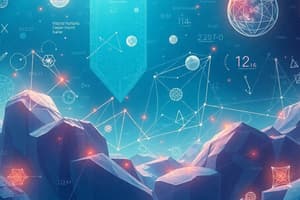Podcast
Questions and Answers
स्थानों को कैसे परिभाषित किया जा सकता है?
स्थानों को कैसे परिभाषित किया जा सकता है?
स्थानों को अंतरिक्ष में स्थितियों के रूप में परिभाषित किया जा सकता है।
क्या है विपरीत अंकों का मतलब?
क्या है विपरीत अंकों का मतलब?
पूर्ण संख्याएँ हैं जो सकारात्मक और नकारात्मक होती हैं।
संभावना क्या है और यह क्या मापन करती है?
संभावना क्या है और यह क्या मापन करती है?
किसी घटना होने की संभावना।
निम्नलिखित क्या है गणित का एक महत्वपूर्ण शाखा जो चरित्रों और उनके संबंधों को संबोधित करती है?
निम्नलिखित क्या है गणित का एक महत्वपूर्ण शाखा जो चरित्रों और उनके संबंधों को संबोधित करती है?
कैलकुलस क्या है और यह किसे अध्ययन करता है?
कैलकुलस क्या है और यह किसे अध्ययन करता है?
गिनती क्या है?
गिनती क्या है?
गणित की मूलभूत सिद्धांतों में क्या शामिल है?
गणित की मूलभूत सिद्धांतों में क्या शामिल है?
वर्णमाला क्या है?
वर्णमाला क्या है?
अभिगमन और विरोध क्या है?
अभिगमन और विरोध क्या है?
गुणा और भाग क्या है?
गुणा और भाग क्या है?
Flashcards are hidden until you start studying
Study Notes
Math: The Language of Patterns and Problem-Solving
Math, short for mathematics, is a fascinating subject that explores patterns, relationships, and reasoning in the world around us. It's a language all its own, filled with symbols, numbers, and logical structures. Let's dive into this incredible field, examining some of its key ideas and concepts.
Foundational Math Concepts
Math's foundations rest on the principles of numbers and operations. These include:
- Counting: The process of assigning a number to each object in a set, or collection, to determine its size.
- Numerals: Symbols that represent numbers, such as 0, 1, 2, 3, and so on.
- Addition and Subtraction: Combining or separating numbers to create new values.
- Multiplication and Division: Repeated addition or subtraction to find the product or quotient of numbers.
- Properties of Operations: Rules that govern the behavior of mathematical operations, such as the commutative, associative, and distributive properties.
Arithmetic and Algebra
As math students progress, they discover arithmetic and algebra. Arithmetic revolves around the addition, subtraction, multiplication, and division of whole numbers and decimals, while algebra deals with letters, called variables, that stand for unknown numbers.
- Whole Numbers: Positive integers and zero.
- Decimals: Fractions with a whole number and a decimal point.
- Fractions: Parts of a whole represented by a numerator and a denominator.
- Integers: Whole numbers, positive and negative.
- Algebra: The branch of math that deals with variables and their relationships.
Geometry
Geometry, the study of shapes and spatial relationships, is another vital branch of math.
- Points: Locations in space.
- Lines: Extended one-dimensional objects that never end.
- Planes: Two-dimensional surfaces that never end.
- Shapes: Two-dimensional figures like circles, squares, and triangles; three-dimensional shapes like cubes, pyramids, and spheres.
- Properties: Characteristics of shapes and their relationships, such as angles, sides, and areas.
Probability and Statistics
In addition to pattern recognition, math also provides us tools to interpret data and make predictions.
- Probability: The likelihood of an event occurring.
- Statistics: The collection, organization, analysis, interpretation, and presentation of data.
- Descriptive Statistics: Measures of central tendency, dispersion, and shape of data.
- Inferential Statistics: Drawing conclusions about a larger population based on a sample.
- Hypothesis Testing: Determining whether a statement about a population is true or false based on sample data.
Functions and Calculus
As math students advance, they encounter functions and calculus.
- Functions: Relationships between inputs and outputs.
- Linear Functions: Functions with a constant rate of change.
- Exponential Functions: Functions with a variable rate of change.
- Calculus: The study of the rates of change and accumulation of functions.
- Integration: The process of finding the area under a curve obtained by integrating a function.
Applications
Math is not just a subject; it's a tool. It's used in various fields, from finance to engineering to biology, to solve real-world problems.
- Solving Problems: Math equips students with the skills to analyze and tackle problems in various contexts.
- Communication: Math provides a common language for scientists to communicate their findings, ideas, and results.
- Critical Thinking: Math encourages students to develop logical and analytical thinking skills.
- Real-world Applications: Math is applied to a wide range of fields, including engineering, architecture, medicine, and economics.
Conclusion
Math is an intricate and fascinating subject that provides a language for understanding patterns, relationships, and problem-solving. Its concepts and principles are applicable to various fields, equipping students with critical skills and encouraging a love of learning. As you continue to explore math, you'll discover even more exciting facets of this incredible subject.
Studying That Suits You
Use AI to generate personalized quizzes and flashcards to suit your learning preferences.




